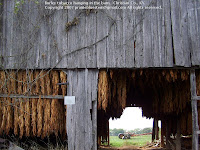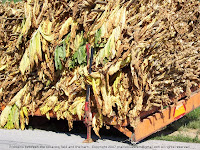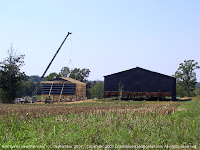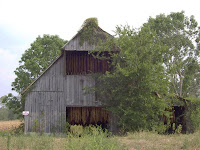Seen in Christian County, KY
There's plenty of time to take a picture, when following a buggy uphill. They are extremely slow, but I never pass them on a hill, even if I'm in a terrible hurry. I figure that it's better to be a few minutes late than to risk a collision. However, I often see impatient drivers who pass without a clue of what's coming in the other lane.
Tobacco is curing in the barns of Christian County, KY. This old barn, built right beside a back road, is always closed tight, with a "No Trespassing" sign on the doors. When I drove by last week, I was surprised to see its doors opened wide.
This clump of trees in the middle of a Christian County field probably marks an old family graveyard. It's sad that so many old cemeteries receive no care at all, but when the families are unavailable, unable, or uninterested, the burden of upkeep falls on the landowner. Most farmers adopt an attitude of benign neglect, and nature takes its course.
Autumn color in Hopkinsville (KY). Some people around the county have reported heavy frost, but we haven't had a killing frost at our house yet. I still have impatiens blooming, though their days are surely numbered.
And who's that crowding into the picture with the impatiens? Why, it's Sophie, of course, doing her best to be the center of attention. I'm in the process of building an elaborate doghouse for her. It has two rooms, and it's better insulated than our house is! I am not a very fast carpenter, so it's still going to require a couple more days of work. And it's so heavy that I'm thinking we might put it in the truck and drive it to the carport, instead of trying to carry it.









































